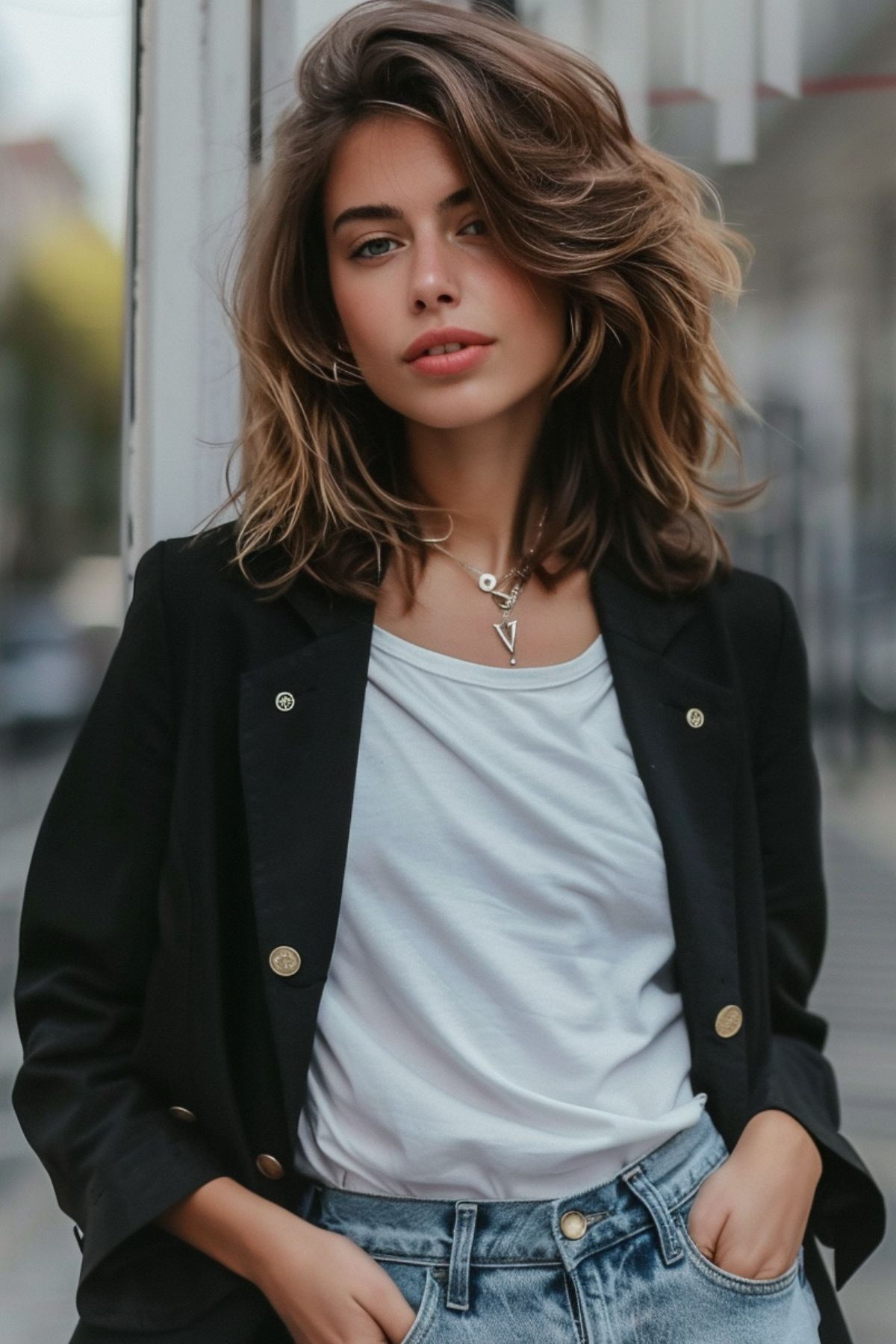Blonde hair is beautiful, bright, and eye-catching.
However, it can also look one-dimensional at times.
This is where adding lowlights comes in.
Lowlights add depth and dimension to blonde hair, making it look more natural, layered and textured.
Lowlights don’t have to be boring or make your hair look dull.
When done right, lowlights can enhance your blonde hair and take it from flat to fabulous.
Today let’s look at TOP gorgeous yet subtle ways to add lowlights to blonde hair.
Baby lights
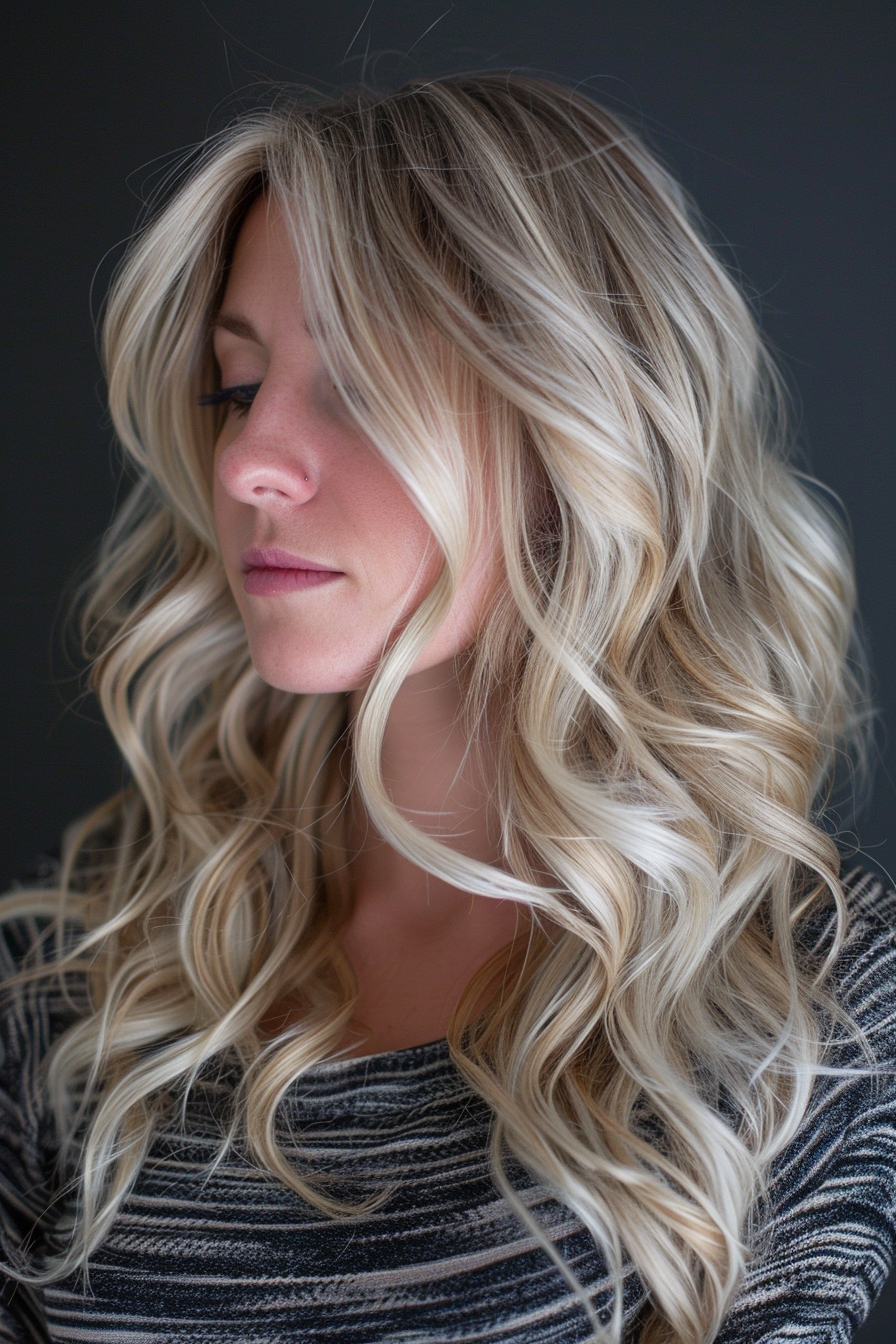
Babylights are a subtle way to add lowlights to blonde hair. As the name suggests, the thin, wispy streaks of color resemble baby hair.
Babylights add gentle dimension to blonde hair, making it look naturally sun-kissed.
How to get babylights:
The key is keeping the babylights extremely fine and delicate.
Thin sections of hair are lightened a few shades darker than your base blonde. A skilled colorist will paint on the lowlights to look like they are growing out from the roots.
The babylights are concentrated around the face and crown to frame your features. Avoid chunky highlights and opt for a soft, barely-there effect.
Babylights work best on light to medium blonde hair.
On darker blondes, the lights may not show up.
The subtle color contrasts gently catches the light, adding shape and texture.
Babylights are great for anyone who wants to soften up their blonde hair and add natural-looking dimension.
Those with thin or fine hair should avoid heavy babylights as it may overwhelm your strands.
Maintenance:
Babylights grow out gracefully and need minimal maintenance.
A touch up every 4-6 months should suffice.
Use a toning shampoo to keep your blonde and lowlights looking fresh in between salon visits. Overlapping lightener with each appointment will damage your hair over time.
Bronde
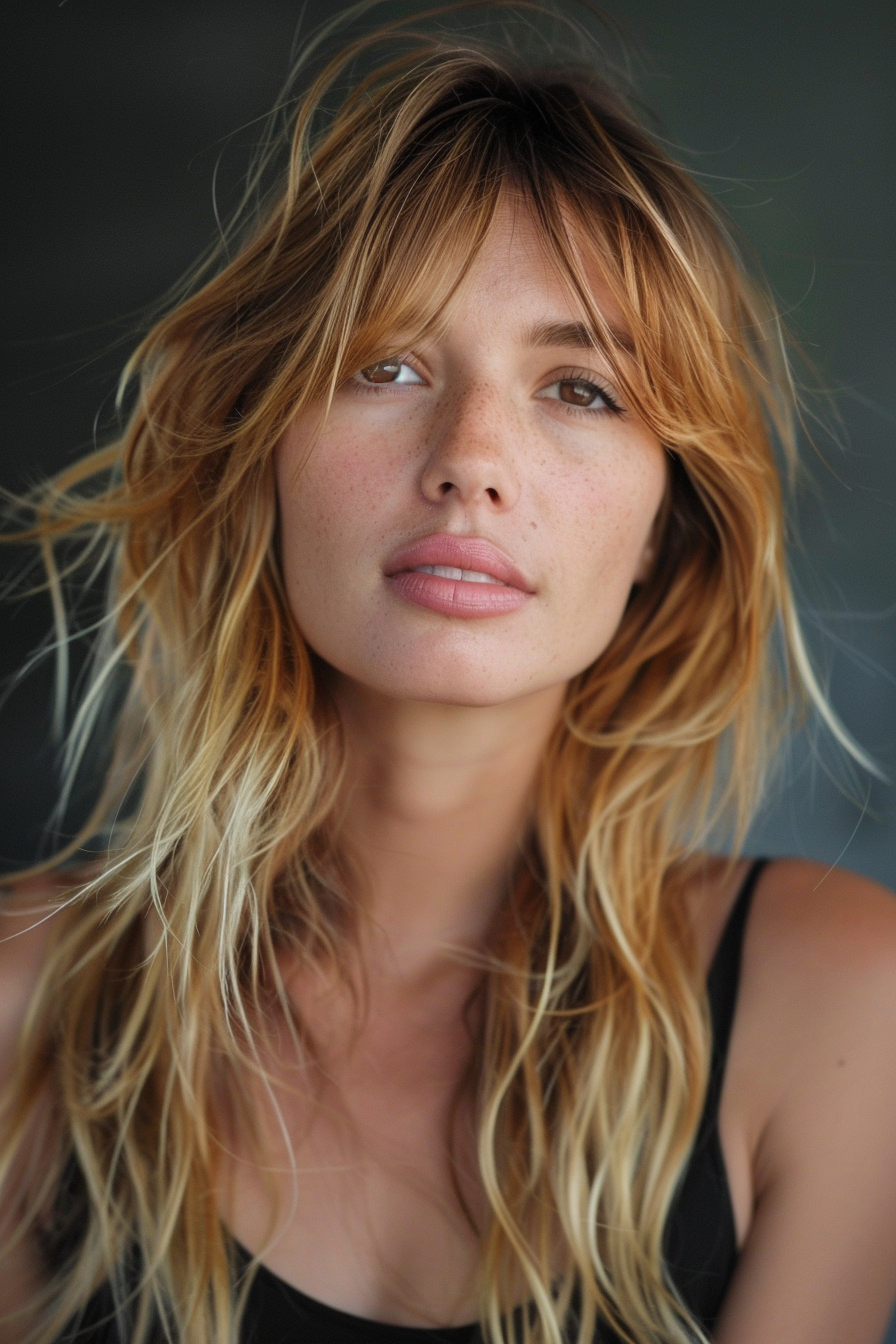
Bronde (brown + blonde) hair is one of the hottest color trends right now.
By adding brown lowlights to golden blonde hair, you get a multidimensional look that flatters most complexions.
The brown adds neutral warmth while the blonde lightens up your overall look.
Well-blended bronde hair should look like you spent all summer in the sun, kissing your hair with natural sunkissed highlights.
How to get bronde hair:
Have your colorist focus the brown lowlights around the roots and mid-lengths, keeping the ends lighter. This gives a “grown out” look.
The level and tone of brown can vary.
For a subtle bronde, opt for light ash brown or beige brown lowlights.
For a more striking contrast, go for a deep chocolate brown.
Keep the lowlights concentrated around the perimeter of your face to beautifully frame your features. Seamlessly blend the brown into the blonde to get that sun-touched effect.
Bronde is suitible for light to dark blonde hair, cool to warm skin tones, and most hair lengths and textures.
The neutral brown tones tend to be flattering on most complexions. It’s a great option if you want to tone down brassy blonde hair or add some edge to platinum and icy blondes.
Maintenance:
Refresh your bronde look every 4-6 months as the brown will fade faster than the blonde.
Use a purple shampoo to prevent the blonde from getting too brassy.
Overlapping lightener with each appointment will damage your hair.
Ask your stylist to tweak the formula over time to maintain vibrancy and dimension.
Blondes and Browns Balayage

Balayage is a freehand highlighting technique that results in soft, natural-looking color patterns.
By hand-painting brown and blonde shades on the mid-lengths and ends, you can get beautiful, lived-in dimension that looks like its been sun-kissed.
Keeping the roots darker not only creates contrast, but also makes your color grow out seamlessly.
How to get blonde and brown balayage:
Ask your stylist to focus most of the highlights around the mid-lengths and ends, leaving the roots darker. The lighter pieces should be painted on for a diffused, melt-like effect.
Depending on how bold you want to go, choose lighter beiges, warm caramels, light browns and buttery blondes painted throughout the lengths.
Keep the highlights finest around the face. This makes the dimension look natural and soft. Avoid chunky streaks.
Balayage works well on most blonde shades and hair types.
Whether you have baby fine hair or thick curly locks, balayage can be customized to your hair.
The seamless grow out makes this look low-maintenance.
Maintenance:
Plan on touching up your balayage every 4-6 months. Always apply shampoo very gently on the ends to keep the lightness vibrant.
Use a toning shampoo or mask to prevent brassiness. As your hair grows out, ask your colorist to focus the lighter shades on the mid-lengths to ends and keep refreshing the regrowth.
Rooted Blonde
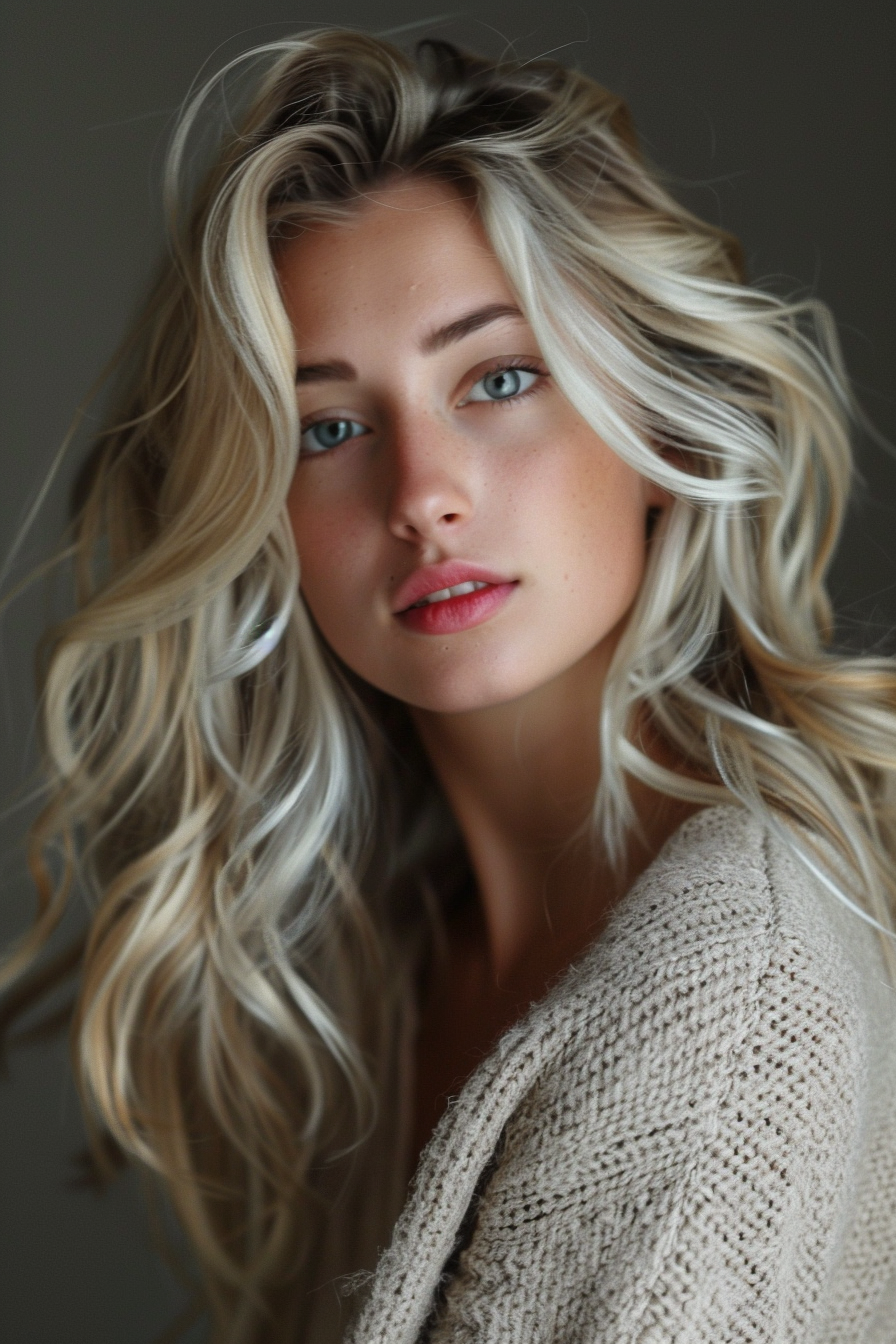
There’s a brand new blonde in town – meet the modern rooted blonde.
This on-trend look maintains darker roots with brighter, lighter ends.
The two-toned effect creates gorgeous dimension and an edgy look.
The darker roots also make your color grow out more seamlessly while allowing you to push the lighter tones.
How to get the rooted blonde look:
Talk to your colorist and decide how bold you want to go with the contrast.
For subtle roots, go just a shade or two darker than your base.
For high-impact roots, try going 3-4 shades darker. Warm brown and beige roots look beautiful and natural against light to medium blonde lengths.
Your colorist will apply the darker root color all over, then lighten the mid-lengths and ends. Avoid a harsh line of demarcation. The roots should melt into the lighter lengths.
Focus on keeping the ends bright and saturated. Toner is key to neutralizing any brassiness.
This edgy look works on most natural or bleached blondes, whether your base is cool, warm, dark or light. Ready to commit to your roots?
This low-maintenance look will reward you with fabulous dimension.
Maintenance:
Plan on touching up the roots every 4-6 weeks. Time this around when the darker roots start growing out by 1/4 to 1/2 inch.
Use dry shampoo and hairstyles like ponytails to help stretch out the grow out time. Use purple shampoo to prevent brassiness on the lighter ends.
Refresh the lengths only as needed, avoiding overlapping lightener.
Ribbon Lowlights
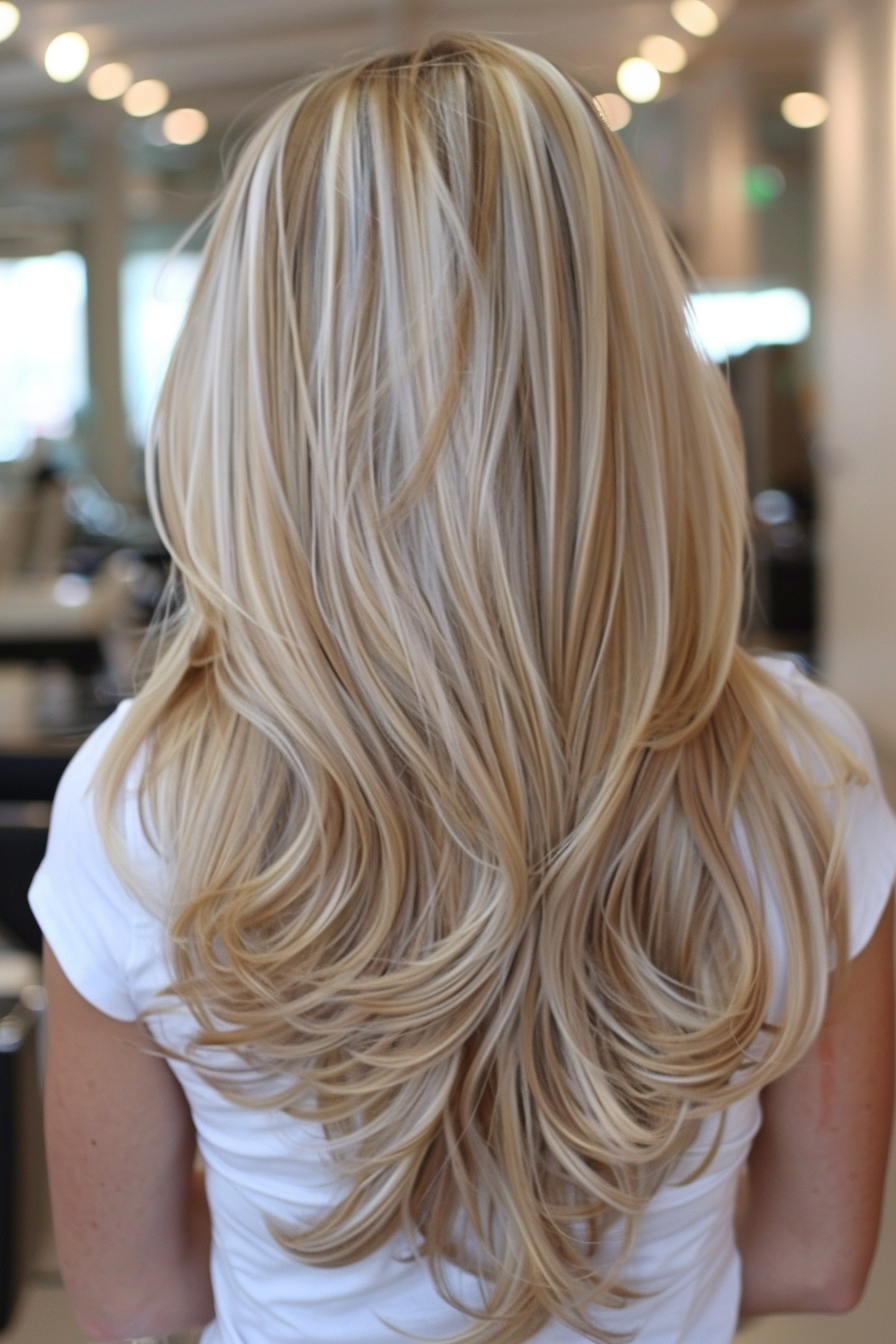
Ribbon lowlights are one of the prettiest ways to add depth and dimension to blonde hair.
Just like their name, these lowlights are applied in thin strands or ribbons throughout the hair.
The contrast creates beautiful movement and texture.
How to get ribbon lowlights:
Have your stylist paint on thin slices of brown hair color throughout the mid-lengths and ends. The ribbons should be about 1/4 inch thick or less.
They can be straight, curved, zig-zagged or wavy. Keep them very narrow to get the ribbon effect. Focus the ribbons around the face and crown to beautifully frame your features.
Chocolate brown, neutral brown and ash brown all create striking, yet natural-looking ribbons. The color should melt when blended with your base blonde.
You can do micro ribbons for a very delicate effect or go for wider ribbons for more contrast. Pair with soft babylights for extra dimension.
Ribbon lowlights complement blonde hair that is all one solid color.
It enhances styles like long layers, curls and waves. The only caution is on hair that is very fine, where ribbons may feel too heavy.
Maintenance:
Ribbon lowlights last 4-6 weeks before you will notice significant fading. Use a color-depositing shampoo to refresh the colour vibrancy at home.
Time your follow-up salon visit before the ribbons become too soft and blended into the base color. Reapply new ribbons on top of the old ones to maintain contrast.
Face-Framing Lowlights
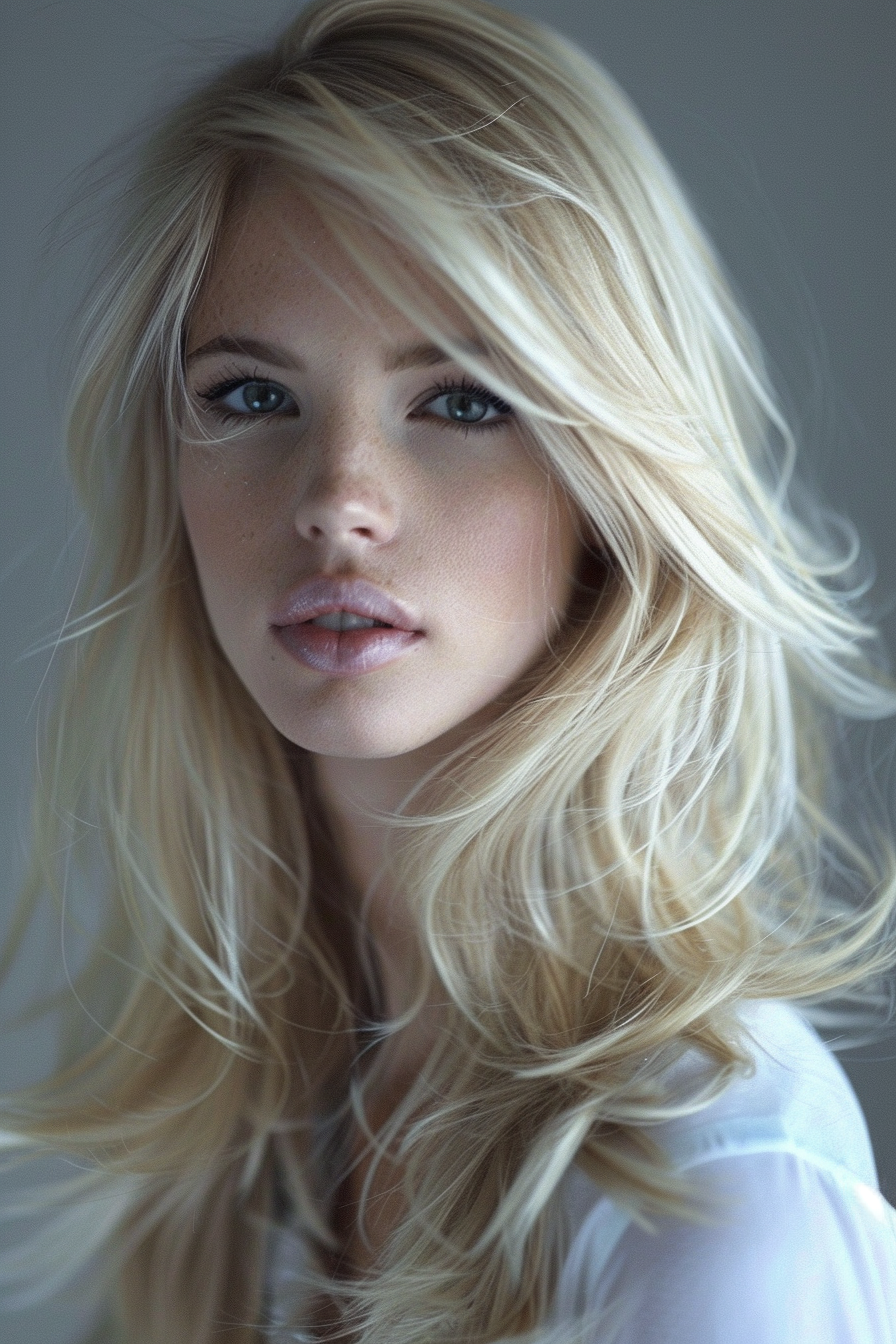
Strategically placed lowlights around the face can perfectly complement your facial features.
Frame your face in dimension while creating mension and movement.
How to get face-framing lowlights:
Focus chocolate brown, neutral brown or ash brown lowlights around the front of your hairline and eyes.
Keep them soft and blended – you want them to naturally accentuate your cut.
Lowlights around the cheekbones, eyes or chin can make these facial features pop. Avoid a blunt, stripey effect by softly diffusing the roots.
Concentrate most of the density of lowlights near the focal points of your face.
This creates dimension while keeping the look natural. Lift the concentration as you move further back.
Babylights, ribbon lights or a partial balayage blend are great to pair with face-framing lowlights.
This technique flatters oval, heart, round and square face shapes beautifully. It tends to softly contour facial features. Talk to your stylist about the placement that will most flatter you.
Maintenance:
Refresh your face-framing lowlights every 4-6 weeks as needed when the roots start growing in. Use a hydrating shampoo and gentle styling to keep ends healthy. Avoid pulling hair tight around the face which can aggravate the hairline.
Shadow Roots
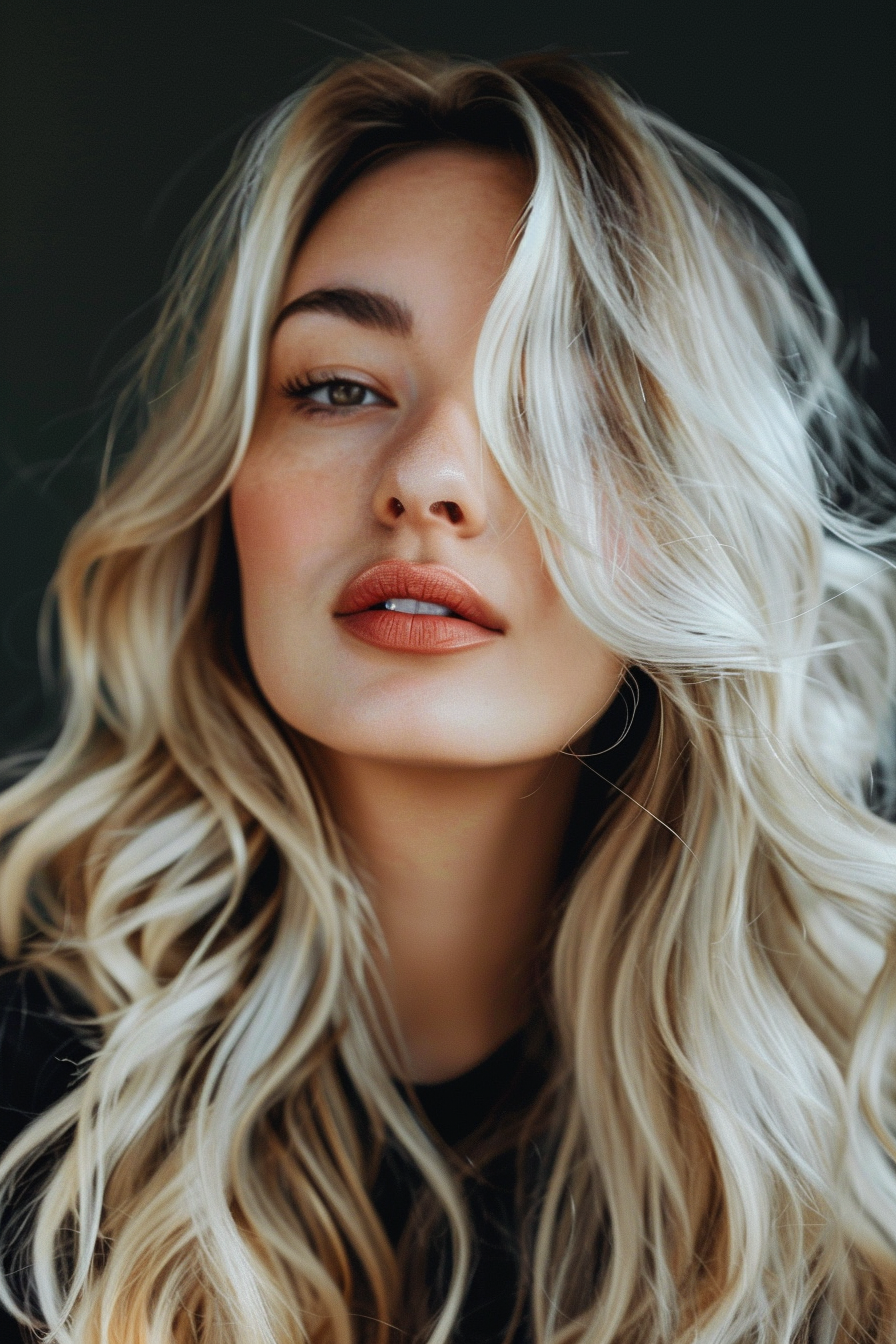
If you’re looking for a bold, striking contrast – shadow roots are your new go-to look.
Shadow roots pair darker roots with lightened ends for major dimension.
How to get shadow roots:
Choose a brown shade that is 2 or more shades darker than your natural level. Warm chocolate browns and neutral ash browns make beautiful bold shadows.
For high contrast, go as dark as an espresso brown. Apply the root color all over first.
Next, lighten the mid-lengths and ends significantly lighter.
For softness, make sure to slightly diffuse and soften the root regrowth line. Avoid a blunt disconnect between your roots and ends. Finish with toner to neutralize brassiness and add shine.
This edgy look loves blondes who are not afraid to push the contrast envelope with their regrowth.
Expect major dimension that makes a statement. It works with straight, wavy or curly hair.
Maintenance:
Get ready to become best friends with your colorist, as shadow roots need touching up every 4 weeks.
Time your appointments based on when the darker roots grow out by 1/2 inch.
Pre-book your next couple appointments to stay on top of your regrowth. Use dry shampoo and updos to help stretch out your shadow roots in between salon visits.
Butterscotch Lowlights

Butterscotch lowlights are the sweet secret to warming up cool-toned blonde hair.
The pale beige-caramel shades blend beautifully into platinum, baby blonde and icy tones to create soft contrast.
How to get butterscotch lowlights:
Focus buttery nougat, toffee and cream-colored lowlights around the mid-lengths and ends of your hair. Keep the roots and crown area cool-toned to avoid looking brassy.
The butterscotch paint should melt into your base color for a seamless look.
Avoid chunky blocks of color.
The effect is much more subtle than traditional honey-brown lowlights.
When strategically placed throughout the lengths, butterscotch lowlights offset any harshness from icy tones.
They give cool blondes added softness, dimension and warmth.
This technique works best on ultra-light blondes looking to warm up their one-dimensional color. It is especially flattering on fair, cool-toned complexions.
Maintenance:
Refresh your butterscotch lowlights after 4-6 weeks when fading occurs. Opt for a demi-permanent glaze that washes out gradually.
Avoid overlapping lightener at the roots which will damage hair. Use a violet-blue shampoo to prevent brassiness and keep the ends icy.
Partial Highlights
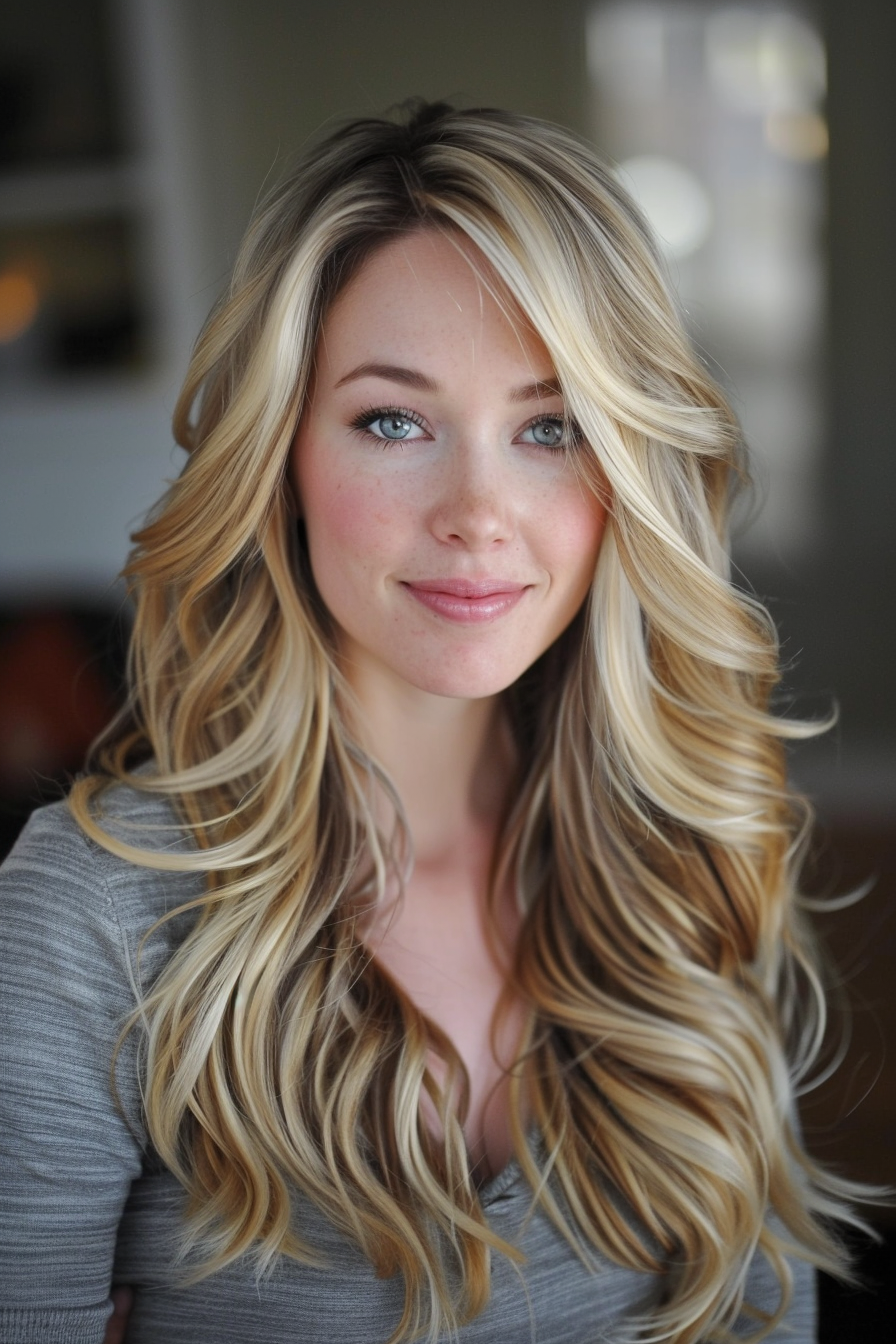
If you’re not ready to commit to full highlights, partial highlights are a great way to gradually introduce lightness to your blonde hair.
By only highlighting the top section and mid-lengths, you can add dimension while keeping your roots and ends natural.
How to get partial highlights:
Ask your stylist to weave subtle platinum or beige foils throughout the top section and mid-lengths of your hair. Keep the foils off the roots and ends for a low contrast look.
The highlighted pieces will blend with your natural base for a low-maintenance grow out.
Concentrate lighter babylights around your face and eyes for the most flattering wear. Avoid heavy chunky highlights.
For more depth, pair with root smudging and lowlights throughout the lengths.
The overall look remains relatively natural with a hint of brightness.
Partial highlights allow you to test out highlights without fully committing.
They are perfect for blondes seeking very subtle sun-kissed accents to their natural hair. It creates the illusion of natural lightened hair.
Maintenance:
With only your mid-lengths highlighted, regrowth is less noticeable and the grow out remains seamless. Plan for a touch up every 4-6 months.
Avoid overlapping lightener on the ends and roots. Use a weekly toning treatment to prevent brassiness.
Sombre Lowlights
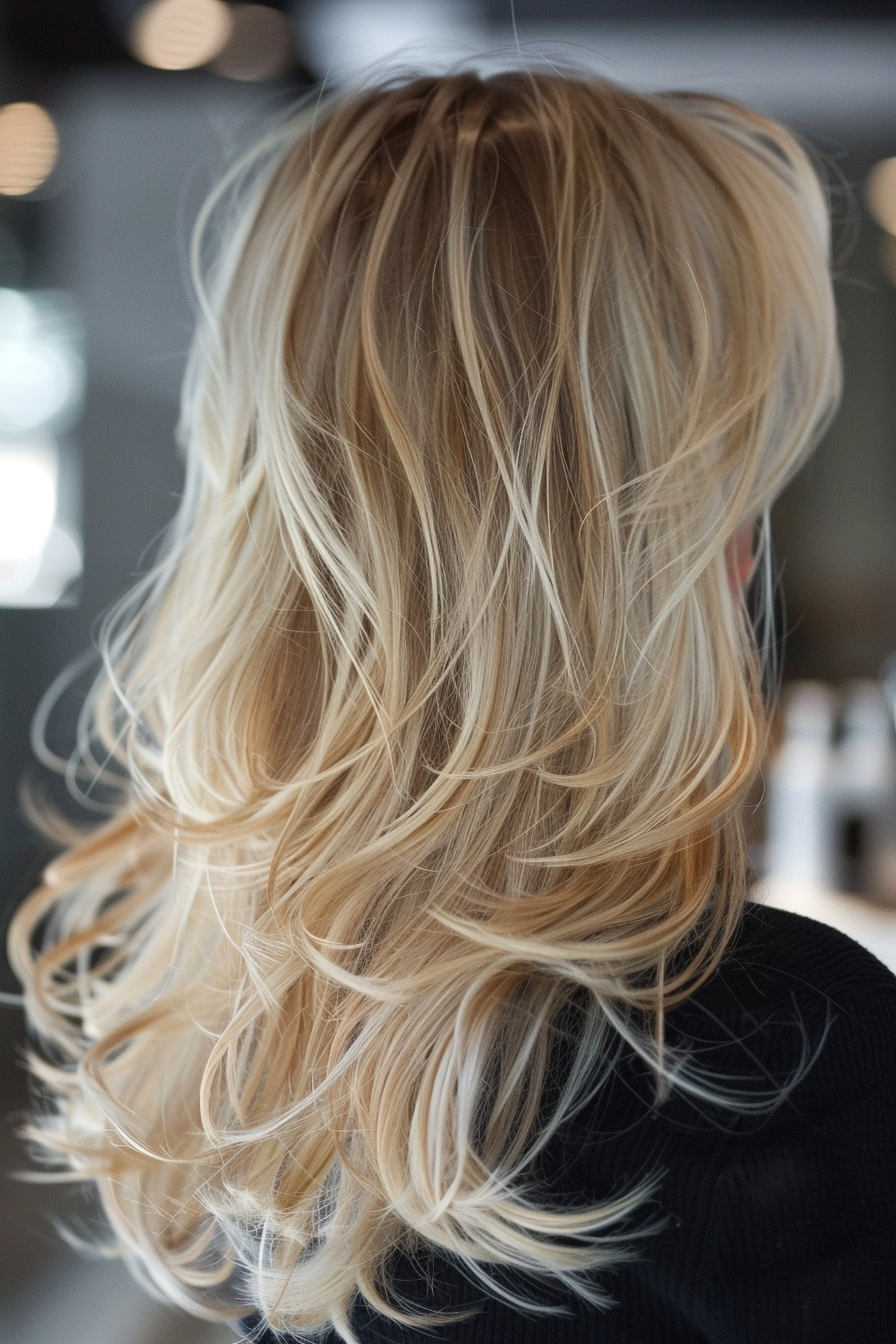
The “sombre” hair color trend combines darker roots with gradually lightening mid-lengths and ends.
It’s a modern take on traditional ombre and balayage techniques. Sombre creates subtle, natural-looking dimension perfect for blondes.
How to get sombre lowlights:
Choose a brown shade 1-2 levels darker than your natural blonde base.
Focus lowlights heavily through the root area, slowly lightening the intensity through the mid-lengths. Avoid a clear line of demarcation between shades.
The ends should fade into pieces that are lightly hand-painted for a soft, diffused effect. Complement the lowlights with babylights and face-framing highlights.
The overall look is understated with hint of natural sun-kissed lightness.
This technique works beautifully on most blonde shades and is very low-maintenance. It provides subtle depth while remaining relatively natural.
Maintenance:
Expect to get your sombre lowlights refreshed every 4-6 months.
The root regrowth blends in seamlessly, while the highlighted ends prevent the look from getting too heavy over time. Avoid using heavy overlapping lightener.
Treat the ends gently to prevent dryness and breakage.
Smudged Root Lowlights

Smudged roots involve blending your natural regrowth into the lightened lengths for a slightly undone, lived-in look.
It helps soften up harsh root regrowth lines for a seamless grow-out.
How to get smudged root lowlights:
Focus on creating a very diffused line between your regrowth and lightened sections during the coloring process. To get a smudged effect, slightly overlap the two shades and blend with a comb.
The roots should look blurred rather than clearly defined.
Pair smudging with lowlights in the mid-lengths and ends for extra dimension. Babylights also complement the technique. Keep the overall look very soft and natural.
Avoid blunt roots or harsh lines which defeat the purpose.
This technique is perfect for blondes growing out their highlights and wanting to disguise uneven regrowth. The smudged effect helps visually blend any variations for a seamless look.
It is especially great for hair that naturally lacks softness.
Maintenance:
To maintain your smudged roots, time your touch ups around 1/2 inch of re-growth. Avoid pulling blonder pieces too far down through the roots during subsequent appointments.
Focus on blending the new growth in using the previous smudged highlights as your guide.
Rooted Smoky Lowlights

For grungy dimension, rooted smoky lowlights combine darker roots with slate gray and brown pieces throughout the lengths.
It’s an edgy yet sophisticated take on traditional highlighting.
How to get rooted smoky lowlights:
Create a dark rooted effect by applying a neutral brown shade like chocolate or ash brown onto the roots first. Next, hand paint slices of darker blonde, brown and smoky shades randomly throughout the mid-lengths and ends.
Focus on softer gray-browns rather than pure gray to keep the look wearable.
Charcoal, ash and mushroom shades work well. Avoid uniform placement to get that undone vibe.
Complement with brighter blonde babylights around the face. Finish with a toner to prevent brassiness.
This bold yet sophisticated look is perfect for natural brunettes wanting to go lighter while still keeping some depth. The multitude of colors creates striking dimension with an edgy feel.
Maintenance:
Prep for more frequent salon visits to refresh your roots and lowlights every 4-6 weeks as the dark colors fade out quickly.
Use a toning gloss to keep the lighter pieces nice and bright. Apply dry shampoo to roots between washes to absorb oil and extend your highlight’s longevity.
Caramel Ribbons

Warm up cool-toned blonde hair beautifully with soft caramel-brown ribbon lowlights.
Strategically painting on buttery caramel ribbons adds dimension while counteracting any icy brass tones.
How to get caramel ribbon lowlights:
Paint thin slices of caramel, cinnamon and warm brown randomly throughout the mid-lengths and ends. Keep them very fine and varied.
Weaving a few babylights helps further soften the look. Concentrate the most ribbons around the face to flatter your features.
Focus on warm caramel notes rather than red tones to keep the finish natural-looking. Avoid chunky streaks for a seamless effect that melts into your blonde base.
Finish with a gloss for multidimensional shine.
This technique livens up one-note blonde hair.
The warm ribbons also minimize yellow tones. It creates natural-looking, soft contrast you can wear year-round.
Maintenance:
Refresh your caramel ribbons every 4-6 weeks as the warm tones tend to fade faster. Use a color-depositing shampoo to help preserve the color in between salon visits.
Avoid overlapping lightener at the roots during touch-ups which will damage and dry out your hair.
Strategically placed lowlights create natural-looking dimension that catches the eye.
Remember to focus the density of lowlights around the face and eyes to flatter your cut.
Keep the ends and roots softer for an undone finish.
Compliment your lowlights with soft baby lights, smudging or ribbons throughout for extra dimension.
No more one-note flat blonde hair – it’s time to highlight your lowlights.
Soften up, warm up or go bold with contrast. Find your perfect blonde balance and take your color to the next level this season.

